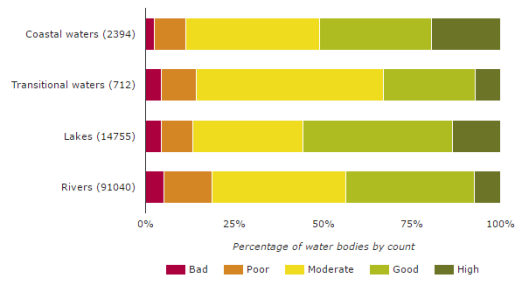Tags
AIRS, Annual Indicator Report, EEA, European Environment Agency, Pollution Series, Surface Water, Water Frameworks Directive, Water Quality
The European Environment Agency’s (EEA) Annual Indicator Report (AIRS) (WWW1) on Surface water has indicated that a large share of EU surface waters are not currently in good ecological status. As such, they are unlikely to reach goal of good status by 2020. This is due to pressures such as pollution, morphological changes, over-abstraction and hydrological changes affecting water flow (WWW2, 9).

Ecological Status or Potential of classified rivers, lakes, coastal and transitional waters, EU (WWW1)
The role of AIRS are to examine if the EU and its immediate neighbours are on target to achieving by 2020 the three thematic priority objectives of the 7th Environment Action Programme. These include:
- Priority Objective 1: Natural capital
- Priority Objective 2: Resource efficiency and low carbon economy
- Priority Objective 3: Health and well-being
Surface Waters are covered under Priority Objective 1 along with:
- Eutrophication of terrestrial ecosystems due to air pollution
- Agricultural land: nitrogen balanceUrban land expansion
- Forest utilisationMarine fish stocks
- Common birds and butterflies
- EU protected species
- EU protected habitats
In 2009 only 43 % of surface water bodies were in good or high ecological status and, in 2015, 53 % of water bodies were expected to reach good ecological status. Despite ongoing efforts, the EEA has indicated that this is a modest improvement in water quality since 2009 and as such it is unlikely that the objective of achieving good status of waters in the EU will be met.
The report concludes that the “full implementation of the management measures under the Water Framework Directive (WFD), in combination with full implementation of other relevant directives (e.g. Urban Waste Water Treatment, Nitrates Directive) is needed in order to restore the ecological status or potential of surface waters.”(WWW2) The EU Water Frameworks Directive is an EU environmental legislation that focuses on improving our water environment and applies to rivers, lakes, groundwater, estuaries and coastal waters. Specifically the WFD aims to (WWW3*):
- protect/enhance all waters (surface, ground and coastal waters)
- achieve “good status” for all waters by December 2015
- manage water bodies based on river basins (or catchments)
- involve the public
- streamline legislation
If you would like to learn more about the issues affecting Irish water quality, read our Deep Maps Pollution Series
*Note: WWW3 relates only to the first cycle of River Basin Managements Plans for the period from 2009 to 2015. The second and subsequent cycles are available via www.catchments.ie
Orla-Peach
–References–
EU, 2000, Directive 2000/60/EC of the European Parliament and of the Council of 23 October 2000 establishing a framework for Community action in the field of water policy (OJ L 327, 22.12.2000, p. 1–73).
WWW1 – Surface Water
WWW2 – Annual Indicator Report 2016
WWW3 –The EU Water Frameworks Directive
